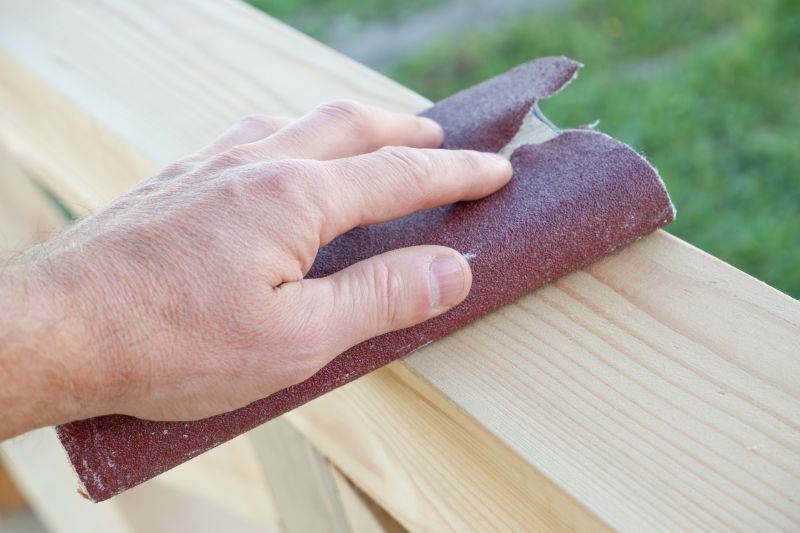Leading Choices In Exterior Deck Sanding Equipment
Compare top products designed to handle various deck surfaces and ensure a smooth, durable finish every time.
 Exterior deck sanding is an essential step in maintaining the longevity and appearance of outdoor wooden surfaces. Proper sanding removes old finish, weathered wood, and surface imperfections, creating a smooth base for new stain or sealant application. Selecting the right products for deck sanding can significantly influence the ease of the process and the quality of results. From manual hand sanding tools to powered electric sanders, the variety of options caters to different deck sizes, wood types, and user preferences. Understanding the characteristics of each product type helps in choosing the most suitable tools for specific projects.
Exterior deck sanding is an essential step in maintaining the longevity and appearance of outdoor wooden surfaces. Proper sanding removes old finish, weathered wood, and surface imperfections, creating a smooth base for new stain or sealant application. Selecting the right products for deck sanding can significantly influence the ease of the process and the quality of results. From manual hand sanding tools to powered electric sanders, the variety of options caters to different deck sizes, wood types, and user preferences. Understanding the characteristics of each product type helps in choosing the most suitable tools for specific projects.
Top Overall Option
Electric Orbital Sander
An electric orbital sander offers a versatile and efficient solution for exterior deck sanding. Its random orbital motion minimizes swirl marks and provides a smooth finish, making it suitable for various wood surfaces. With adjustable speed settings and ergonomic design, it enhances user comfort and control during extended sanding sessions. Compatible with a range of abrasive discs, this tool simplifies the process of removing old finishes and preparing the deck for refinishing projects.
Types of Products For Exterior Deck Sandings
Manual Hand Sanding Blocks
Ideal for detailed work and small areas, hand sanding blocks allow for precise control and are suitable for finishing touches.
Orbital Sanders
Electric orbital sanders provide efficient, even sanding with reduced risk of surface gouging, suitable for large deck surfaces.
Palm Sanders
Compact and lightweight, palm sanders are perfect for tight corners and detailed sanding tasks on decks.
Belt Sanders
Belt sanders are powerful tools for removing heavy paint or stain layers quickly from large wooden surfaces.
Detail Sanding Files
These files are designed for intricate areas and edges where larger tools cannot reach effectively.
Sanding Discs and Pads
Interchangeable abrasive discs and pads compatible with electric sanders, available in various grits for different stages.
Abrasive Sheets and Sandpaper
Handheld sheets and sandpaper in different grits for manual sanding or finishing touches on deck surfaces.
Dust Collection Attachments
Accessories that connect to power sanders to minimize airborne dust and improve workspace cleanliness.
Synthetic and Natural Abrasives
Various abrasive materials designed for different wood types and finishing requirements.
Sanding Sponges
Flexible sanding sponges conform to surfaces and are useful for detailed or curved areas.
Popular Choices
A widely used power tool for efficient and smooth sanding of large deck surfaces, compatible with various abrasives.
Versatile and accessible, hand sanding blocks are common for detailed work and touch-ups.
Popular for their ease of use and effectiveness on medium-sized deck areas.
Preferred for heavy-duty removal tasks, especially on older or heavily stained decks.
Available in multiple grits, these are essential for quick material removal and surface preparation.
Handheld sheets are favored for finishing and detailed sanding, offering control and precision.
Increasingly popular to reduce airborne dust and maintain a cleaner workspace.
Useful for intricate areas and edges where larger tools cannot reach.
Flexible and adaptable for curved or uneven surfaces on decks.
Commonly used for their durability and consistent performance across various wood types.
Achieving a uniform, clean surface requires not only the right tools but also the appropriate abrasives and accessories. Different grits of sandpaper or sanding discs are used at various stages of the process, starting with coarser grits to remove roughness and progressing to finer grits for finishing. Power sanders such as orbital or palm sanders offer efficiency and consistency, especially on larger decks. Meanwhile, hand sanding provides precision and control for delicate areas or detailed work. Proper safety gear, including masks and eye protection, is also crucial during sanding to prevent inhalation of dust and debris.
When selecting products for exterior deck sanding, considerations include the compatibility of abrasives with the wood type, the ease of handling, and the overall durability of the tools. Investing in quality products can make the sanding process more manageable and yield a better surface for subsequent treatments. Regular maintenance and correct usage extend the lifespan of sanding equipment, making them a worthwhile addition to any outdoor maintenance toolkit. Whether undertaking a small refresh or a major restoration, choosing the right products ensures a smooth, effective sanding experience that prepares the deck for its next phase of finishing.
Key Buying Considerations
- Type of sanding tool (manual vs. electric) based on project size and detail level.
- Grit selection of abrasives to match the stage of sanding, from coarse to fine.
- Compatibility of abrasive discs and sheets with the chosen power tools.
- Ergonomic design and weight for comfortable handling during extended use.
- Adjustable speed settings to control sanding aggressiveness.
- Dust collection features to maintain a cleaner work environment.
- Durability and quality of the abrasive materials for consistent performance.
- Ease of changing or replacing abrasive pads and discs.
- Size and shape of tools to suit different areas of the deck.
- Power source compatibility (corded or cordless options).
- Safety features such as vibration reduction and secure grip.
- Availability of accessories and replacement parts.
- Budget considerations balanced with product quality and features.
- User reviews and ratings to gauge reliability and effectiveness.
- Brand reputation and after-sales support.
